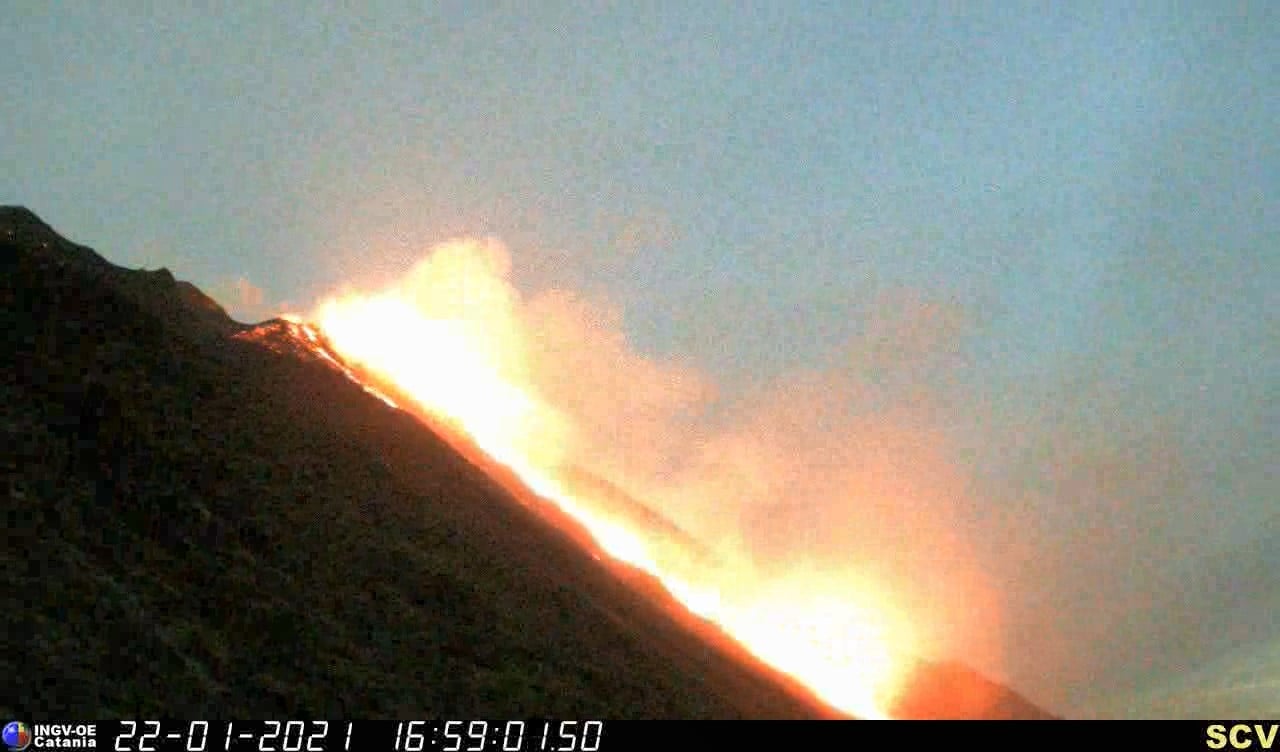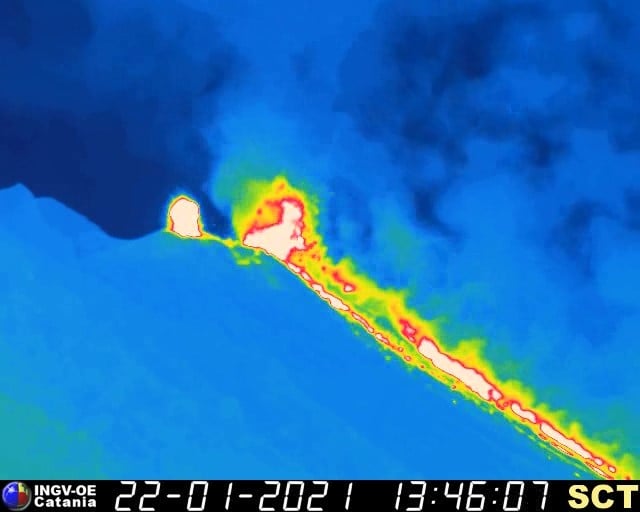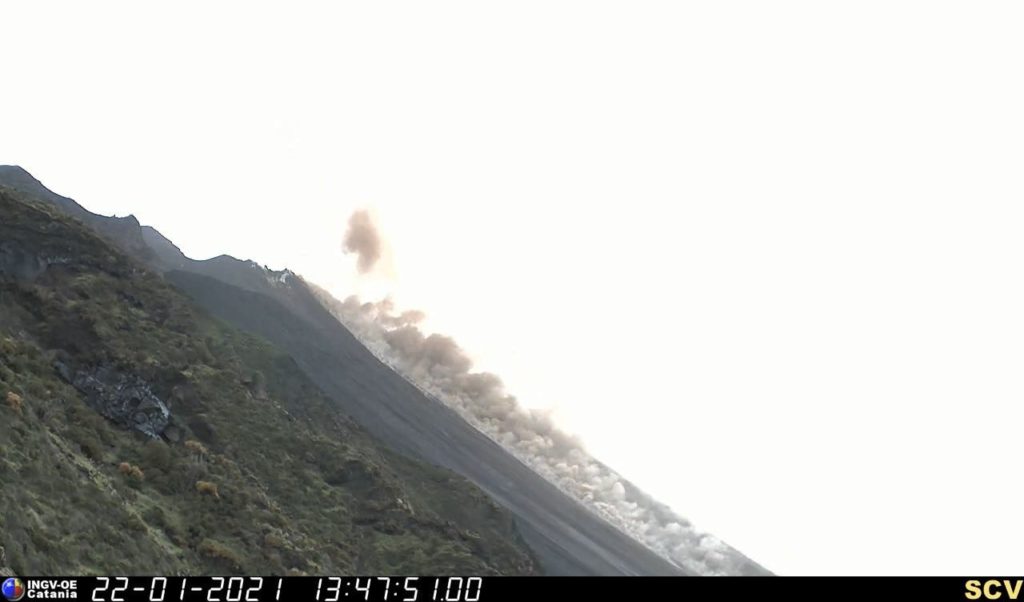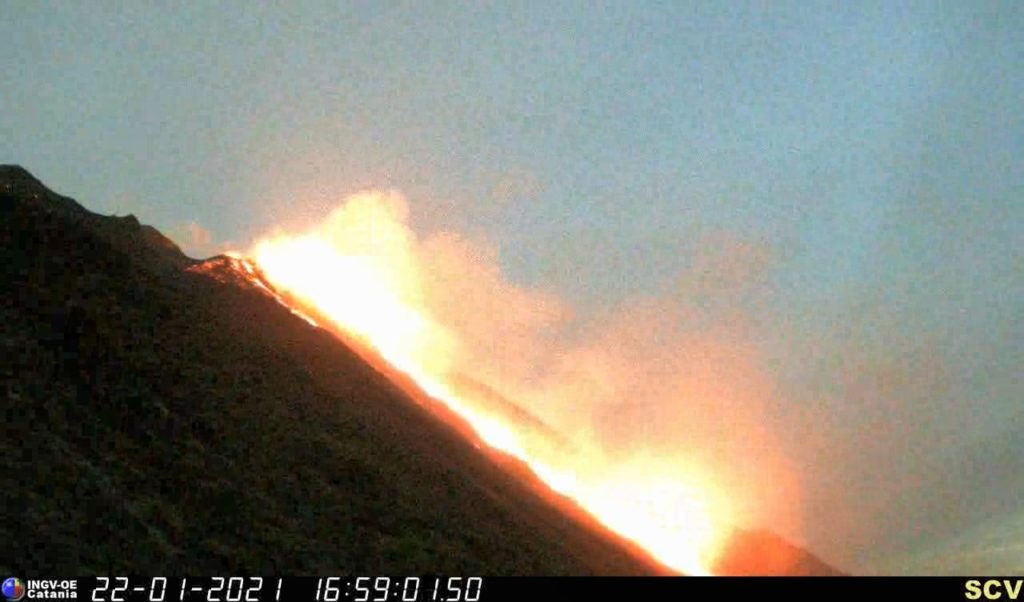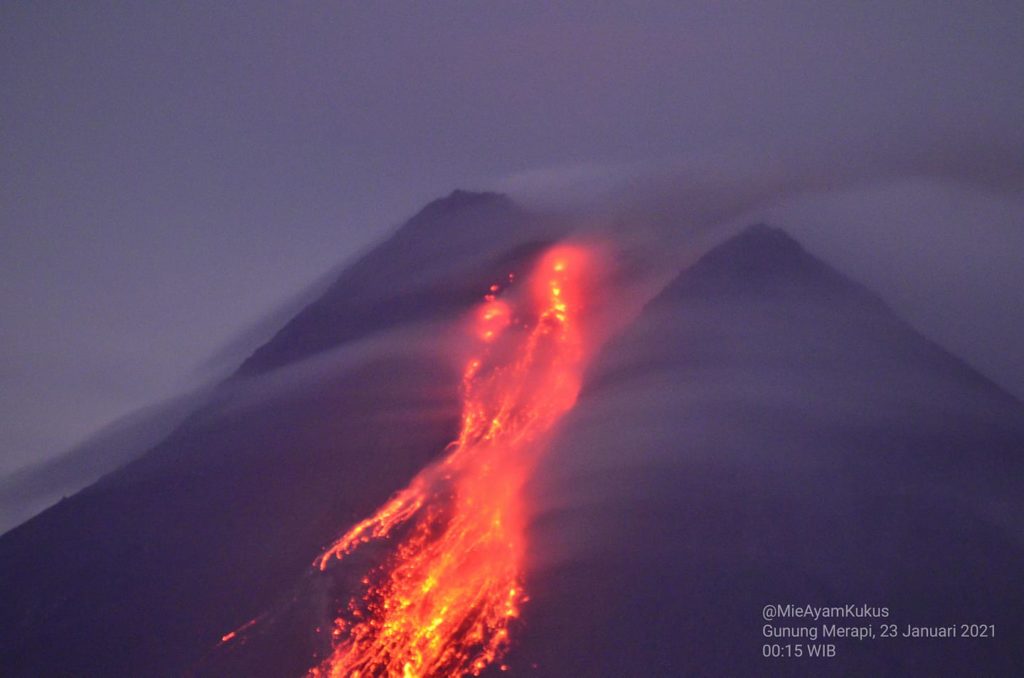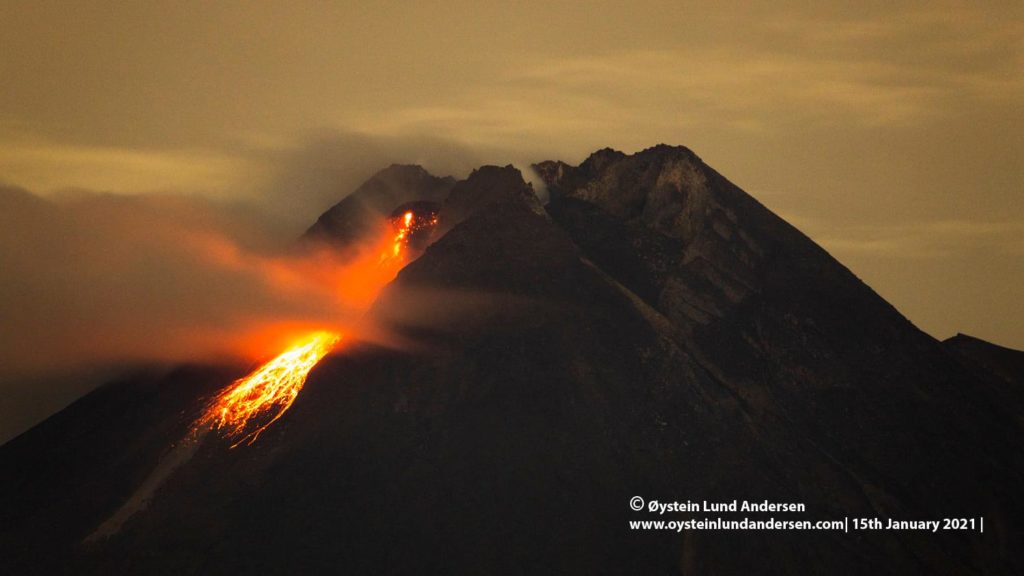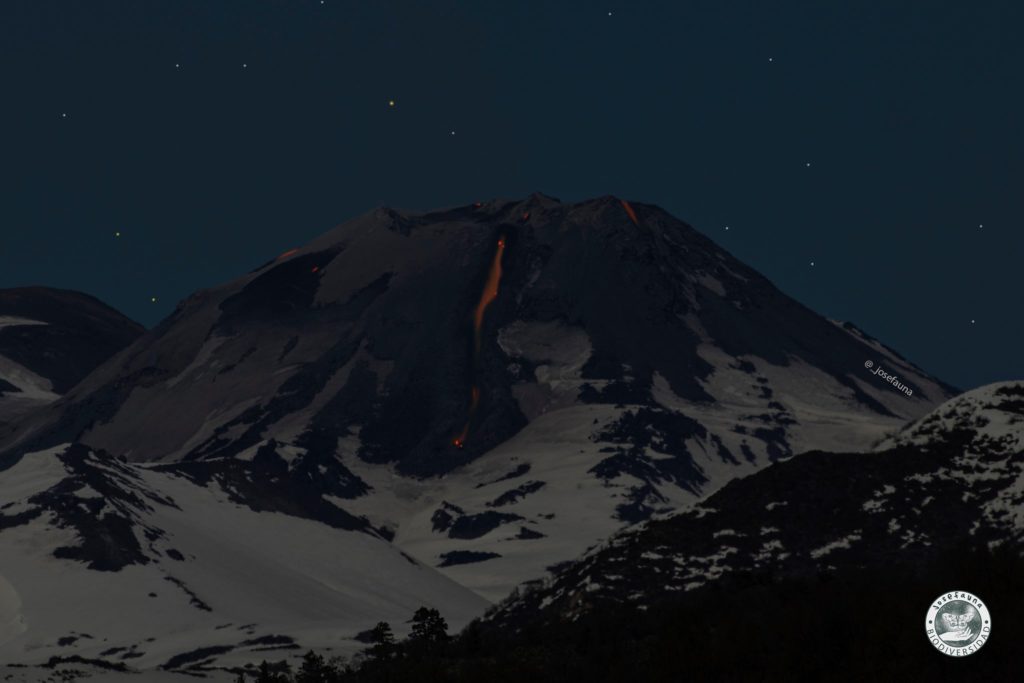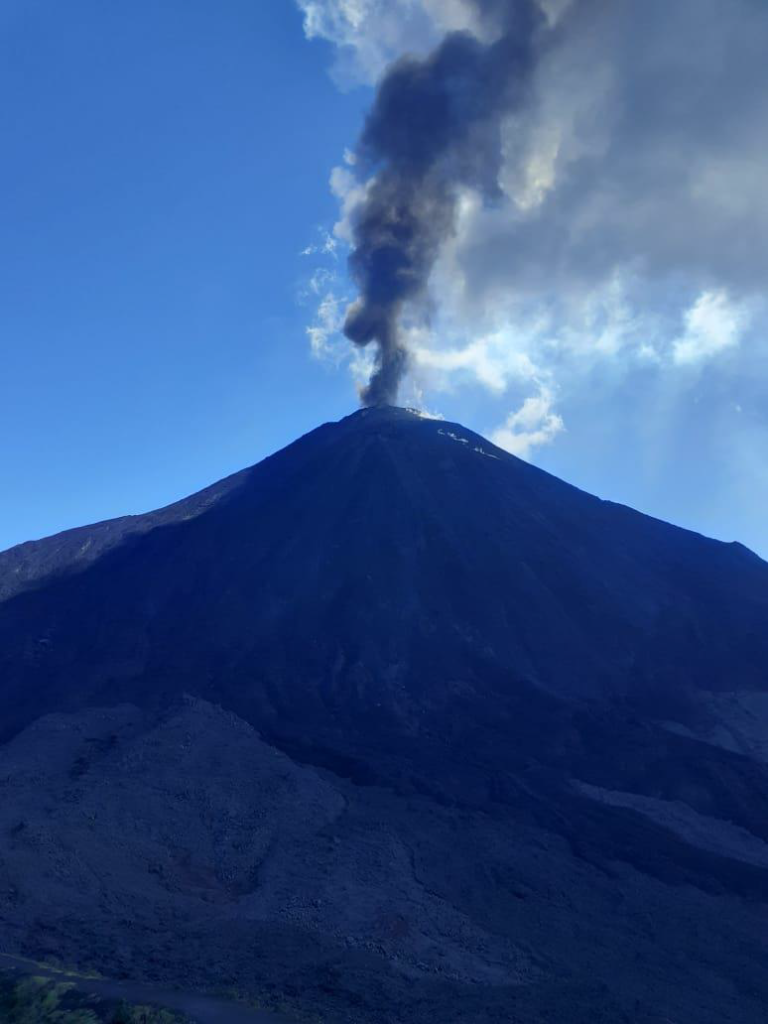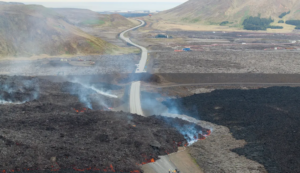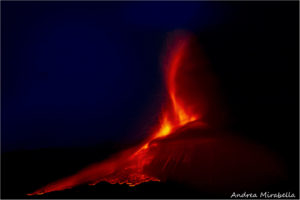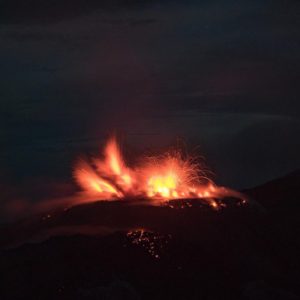January 23 , 2021 .
Italy , Stromboli :
PRESS RELEASE ON STROMBOLI’S ACTIVITY [n. 1]
The National Institute of Geophysics and Volcanology, Osservatorio Etneo reports that the monitoring networks recorded a sudden change in the monitored parameters at 12:43 (11:43 UTC).
In particular, a thermal anomaly is observed from the surveillance cameras.
PRESS RELEASE ON STROMBOLI’S ACTIVITY [n. 2]
The National Institute of Geophysics and Volcanology, Osservatorio Etneo, announces that as of 11:45 GMT, the images of the surveillance cameras INGV-OE show an overflow of lava from the area of the North crater.
Further updates will be communicated promptly and in any event within 3 hours of this press release.
PRESS RELEASE ON STROMBOLI’S ACTIVITY [n. 3]
The National Institute of Geophysics and Volcanology, Osservatorio Etneo, announces that from 13:30 GMT around the CCTV cameras INGV-OE show an increase in effusive activity that feeds the overflow from the area of the north crater. This activity produces clearly visible glowing blocks that break away from the front of the flow and roll along the Sciara del Fuoco.
Regarding the tremor, no significant change is noted.
The deformation data does not show significant changes.
Further updates will be communicated shortly.
COMMUNICATION ON VOLCANIC ACTIVITY of 22/01/2021 16:14:21 (UTC) – STROMBOLI.
The National Institute of Geophysics and Volcanology, Osservatorio Etneo, reports that the lava flow produced by the overflow formed in the area of the North crater continues to be well fed and that the front is at an altitude of about 600 m . The incandescent blocks that break away from the front roll along the Sciara del Fuoco to reach the coast. There is also ordinary Strombolian activity in the North and Central South crater areas.
Concerning the amplitude of the tremor at the STRA station, there is no significant change and it remains at medium-low values. The number and size of explosion tremors show low values.
The deformation data does not show significant changes.
Source : INGV.
Indonesia , Merapi :
Mount Merapi Activity Report, January 15-21, 2021
I. OBSERVATION RESULTS
Visual
The weather around Mount Merapi is generally sunny in the morning, while the afternoon until evening is foggy. There is white smoke, thin to thick, with low pressure. A maximum smoke height of 600m is observed from the Mount Merapi observation post in Selo on January 20, 2021 at 9:23 a.m. WIB.
During this week, avalanches of incandescent lava were observed 282 times with a maximum slide distance of 1000 meters southwest of Kali Krasak and Kali Boyong. Hot avalanche clouds have occurred 19 times with a maximum slide distance of 1,800 meters to the southwest and were recorded on a seismogram with a maximum amplitude of 60 mm and a duration of 209 seconds .
Morphological analysis of the peak area based on photos of the southwest sector from January 21 to January 14, 2021 shows a change in the morphology of the summit area due to avalanche activity and the development of new lava domes . As of January 21, 2021, the measured volume of the 2021 lava dome is 104,000 m3 with an average growth rate of 8,600 m3 / day.
Seismicity
This week, the seismicity of Mount Merapi recorded:
19 hot cloud avalanches (AP),
27 shallow volcanic earthquakes (VTB),
176 multi-phase earthquakes (MP),
836 avalanche earthquakes (RF),
30 emission earthquakes (DG)
8 tectonic earthquakes (TT).
The seismic intensity this week is lower than last week.
Deformation
The deformation of Mount Merapi which was monitored using EDM this week showed a shortening rate of 0.8 cm / day. The speed at which the distance shortens shows a significant decrease.
Rain and lahars
This week there was rain at Mount Merapi Observation Post with the highest rainfall intensity of 33mm / hour for 75 minutes at Kaliurang post on January 21, 2021. There was no rain. lahars or additional flow in the rivers that descend from Mount Merapi.
Conclusion
Based on the results of visual and instrumental observations, it is concluded that:
The volcanic activity of Mount Merapi is still quite high in the form of effusive eruption activity. The state of the activity is defined at the « SIAGA » level
Source : BPPTKG
Photos : Mieayamkuskus , Oystein Lund Andersen .
Chile , Nevados of Chillan :
Nevados of Chillán volcanic complex:
– During the period, 386 seismic events classified as volcano-tectonic type were recorded, associated with fragile rupture processes in volcanic systems; the most energetic event recorded a local magnitude (ML) value of 4.3 and was located 7 km south-southeast of the active crater, with a depth of 3.7 km.
In addition, 1263 seismic events classified as long period type were recorded, associated with the dynamics of fluids present in a volcanic system; the largest earthquake evaluated from the Reduced displacement (DR) parameter had a value equal to 417 cm2. Finally, 589 seismic events were classified as being of the tremor type, associated with the sustained dynamics of the fluids present in a volcanic system; the highest tremor had a DR value equal to 141 cm2.
– 659 events were identified as discrete explosive activity. The highest energy explosion had a seismic signal associated with a DR equal to 417 cm2.
– From the volcanic surveillance cameras, the development of an explosive and effusive activity was recorded during this fortnight. The explosive events are characterized by the generation of eruptive columns less than 1200 m above the level of the crater, with a variable content of particulate matter, where the increase in the frequency of the explosions of the dome with the generation of short-range basal discharge. When weather conditions permitted, a nocturnal incandescence associated with the dome was observed recurrently and focused on the eastern area of the crater.
– Regarding effusive activity, the continuity of growth of the dome is recognized with a greater advance towards the North-North-East and an extension of its fragments on the North-North-East slope, with a distance of 100 m. According to the analysis of satellite images (Planet Scope and Pleiades), the morphologies associated with the partial destruction of the surface portion are recognized, however no significant change was generated. In turn, the emission of the L5 lava flow continues with indications of an acceleration of its emission rate compared to the previous fortnight, and an increase in the opening of the feed crack, with a greater supply of material in the proximal zone, recognized by surveillance cameras. Based on the processing of satellite images (Planet Scope, Sentinel L2 A and Pleiades), we note a distance of 788 m from the edge of the active crater and a forward speed of 0.07 m / h on its front. Through the analysis of digital elevation models, an increase in the total emission rate in December 2020 to 0.2 m3 / s is confirmed, to which is added the acceleration of the L5 dynamic for this fortnight. Until December 2020, a total accumulated volume is measured: 1,401,824 m3.
By processing the available thermal images, maximum temperatures of 333 ° C were observed during the occurrence of explosions and 204 ° C for the L5 lava flow currently located on the North slope.
– According to the data provided by the monitoring stations which measure the deformation in the volcanic complex (5 GNSS and 2 inclinometers), an inflationary process is maintained, possibly linked to increases in pressure inside the volcanic conduits.
Source : Sernageomin .
Photo : Josefauna. ( Sept 2020.)
Guatemala , Pacaya :
EXPLOSIONS WITH ASH COLUMNS.
The surveillance and monitoring of the Pacaya volcano, as part of the Strombolian activity of the Pacaya, records in the last hours of moderate explosions and some strong accompanied by columns of ash which disperse towards the North-West, generating locomotive sounds trains and rumblings with shock waves that vibrate the roofs and windows of the villages near the volcano.
There is a probability that the ash columns in the crater will continue and increase in volume. Due to the change in wind configuration, the ash plume may move north. Ash falls are reported in San Vicente Pacaya and San Francisco de Sales.
All this is part of a phase of Strombolian activity of the Pacaya volcano, which may persist for the next hours and days. On the southern flank, a lava flow is still active which was generated, its lengths varied, reaching more than a kilometer.
INSIVUMEH maintains seismic and visual monitoring through the PCG and PCG5 and OVPAC seismic stations, for any change or increase in activity that can be observed or recorded.
Source et photo : Insivumeh

